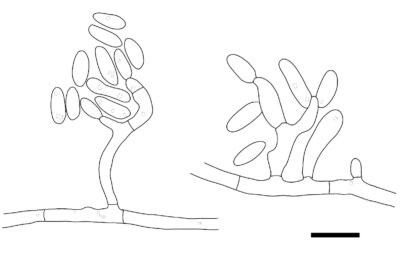Fungalpedia – Note 414, Pseudophialophora
Pseudophialophora J. Luo & N. Zhang
Citation when using this data: Tibpromma et al. 2024 (in prep.) – Fungalpedia, Ascomycota.
Index Fungorum, Facesoffungi, MycoBank, GenBank, Fig. 1
Classification: Magnaporthaceae, Magnaporthales, Sordariomycetidae, Sordariomycetes, Pezizomycotina, Ascomycota, Fungi.
Pseudophialophora was introduced by Luo et al. (2014) as a monotypic genus within Magnaporthaceae and typified with Pseudophialophora eragrostidis based on morphology and multigene phylogeny of SSU, ITS, LSU, MCM7, RPB1 and TEF1-α. Luo et al. (2014) introduced three new species isolated from the roots of Poaceae plants in the USA. Six new species were introduced into this genus, which were isolated from the roots of Poaceae plants in Brazil and the USA (Luo et al. 2015, Crous et al. 2017). Currently, nine species of Pseudophialophora have been isolated from grass rot (Luo et al. 2014, 2015, Crous et al. 2017, Hyde et al. 2020). Pseudophialophora are phialophora-like fungi characterized by dark septate hyphae, simple and short conidiophores, typical phialides, and oblong ellipsoidal unicellular conidia aggregated in slimy heads (Luo et al. 2014). Morphologically, Pseudophialophora is similar to Magnaporthiopsis J. Luo & N. Zhang and Gaeumannomyces Arx & D.L. Olivier in a Phialophora-like conidial state and compressed hyphae (Luo et al. 2014). Magnaporthiopsis differs from Pseudophialophora by having straight conidiogenous cells, wider ovoid conidia, and faster growth rates (Luo and Zhang 2013, Luo et al. 2014). Gaeumannomyces differs from Pseudophialophora in straight conidiogenous cells, sickle-shaped conidia, and faster growing colonies (Luo et al. 2014). Flammeopellis can be distinguished from other genera based on its morphology and phylogeny.
Type species: Pseudophialophora eragrostidis J. Luo & N. Zhang
Other accepted species: Species Fungorum – search Pseudophialophora
Figure 1 – Morphological features of Pseudophialophora eragrostidis. Conidiophores and conidia. Scale bars = 10 μm. Redrawn from Luo et al. (2014).
References
Luo J, Zhang N. 2013 – Magnaporthiopsis, a new genus in Magnaporthaceae. Mycologia 105,1019–1029
Entry by
Liu XF, Center for Yunnan Plateau Biological Resources Protection and Utilization, College of Biological Resource and Food Engineering, Qujing Normal University, Qujing, Yunnan 655011, China; Center of Excellence in Fungal Research, Mae Fah Luang University, Chiang Rai 57100, Thailand; School of Science, Mae Fah Luang University, Chiang Rai 57100, Thailand.
(Edited by Saowaluck Tibpromma, Samaneh Chaharmiri-Dokhaharani, & Achala R. Rathnayaka)
Published online 26 November 2024
